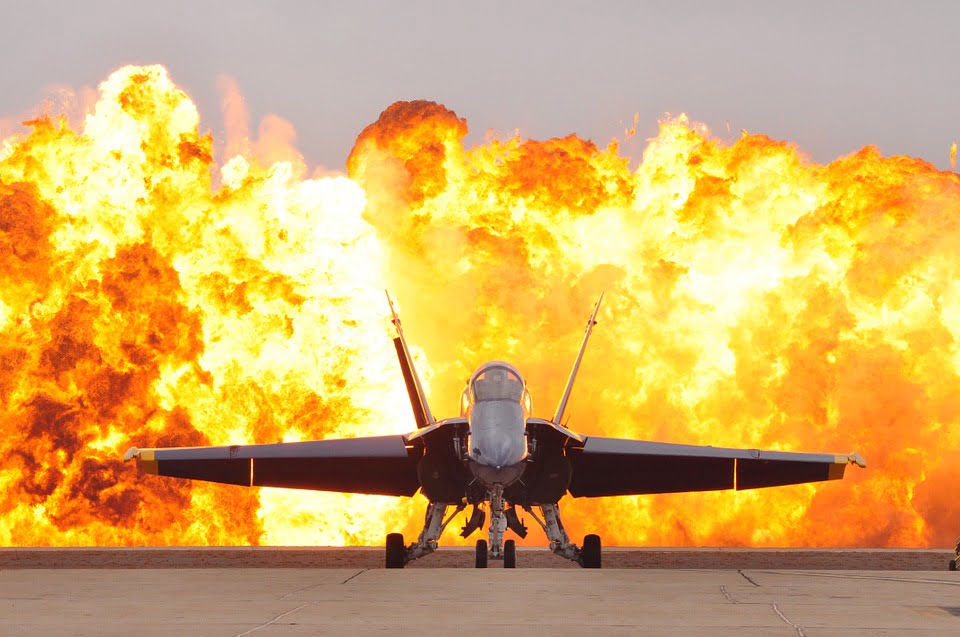Engine Fire In-Flight: Now What?
1. THROTTLE: OFF
2. FIRE LIGHT: DEPRESS
3. FIRE EXTINGUISHER READY LIGHT: DEPRESS
4. ….
These are the first few steps or IMMEDIATE ACTION PROCEDURES (IAPs) that make up the beginning of an emergency situation checklist for an engine fire in a garden-variety high performance aircraft. These steps are listed in BOLD in the checklist and are MEMORY ITEMS (because they are time-critical, they must be performed from memory, NOW). Serving to isolate the source of the problem and keep it from becoming catastrophic, pilots must know their IAPs, and know them COLD.
Business Relevance
Sure this is cool, but why should I care? The aim here is not to make you pilots, of course. But maybe this article will provide a peek into the tactical decision-making process of an efficient and safe industry: airline transportation. It is a timely discussion due to the near-perfect response and actions of US Airways crew of flight 1549 (Jan 15th, 2009) who avoided certain catastrophe through superior decision-making, crew-coordination and airmanship. So many things can and do go wrong in the aviation environment; it is a wonder that there are not more terrible airline disasters. It suggests the question: How do these crews perform at such a high level and with such consistency? The answers lie in the SELECTION, TRAINING, DISCIPLINE, and TRAINING DISCIPLINE of crews, and also in their use of CHECKLISTS. Can these philosophies and practices apply to you in your business; in your life? Can your company, department, sales team be as prepared? Can your operations department, shift, or work cluster consistently land safely when both of your engines are crippled? With that picture painted in your mind’s eye, please read on.
Back to the ENGINE FIRE
It’s almost too silly to say, but I will anyway: not all situations in an aircraft require emergency procedures or IAPs. There are normal procedures which address normal situations such as: start-up, pre-taxi, taxi, climb-out, level-off, pre and post-landing. Abnormal procedures may address things like: engine temperature high on start, low boost-pressure light, landing gear indicates unsafe, etc. One notch of severity above these situations calls for emergency procedures. Flight crews use CHECKLISTS for all of these situations to ensure that situations do not escalate in severity. The goal is to prevent emergencies from becoming CATASTROPHIC, abnormal situations from becoming EMERGENCIES, and to keep normal situations from morphing into ABNORMAL ones. It is an imperative ingredient of the aviation culture that checklists are used consistently, giving crews a place to return when things go wrong. Checklists help us to “go back to what we know works.”
The recent aviation US Airways incident (Airbus 320, two-engine passenger carrier) provides a demonstrative example of how checklists work in the aviation world, and how they are ingrained into procedure. Some detail and assumption follows.
Vanilla: Everyday Pilot Life
After walking-around and preflight-checking the aircraft for external integrity, the pilots take their positions in the cockpit and ‘man’ their workstations (captain=left side, first officer=right). From the cockpit, they go about preparing the aircraft for flight by loading the cockpit computers and avionics systems with the necessary navigation and communications data. They go through a basic cockpit integrity check and then begin their PRE-START CHECKLIST. Using a ‘challenge and response’ technique, the non-flying pilot (NFP) calls out the checklist item (either from a page in a checklist booklet, or from a computer screen in the cockpit) prompting the flying pilot (FP) to accomplish the task. The FP responds that he is in compliance and then the NFP checks to be sure. This pre-start checklist is relatively innocuous and quickly performed. The ENGINE START checklist follows using the same format. The crew then accomplishes the AFTER START and then the PRE-TAXI checklists. While they are taxiing, they do their PRE-TAKEOFF checklist where they make sure the jet is in flying order. As they take the runway, the crew does their TAKEOFF checklist which calls for them to run the motors up, release the brakes, and roll for takeoff. After they lift off, they perform their POST TAKEOFF, CLIMB OUT, and LEVEL OFF checklists. Enroute to their objective, they do the ENROUTE checklist; when they are approaching their arrival area they do the PENETRATION, DESCENT, and APPROACH checklists. Before landing the plane, the PRE-LANDING and LANDING checklists are completed. On landing roll-out and while taxiing to the gate, the appropriate checklists are performed with the final one being the AIRCRAFT SHUTDOWN checklist. That’s a lot of checklists! It’s not sexy, but this is how pilots operate with an impressive degree of safety, consistency, and discipline.
It is important to note that any of these checklists could be performed from memory by the experienced crew member. But the actual POINT of the process is to NOT memorize them. These steps are too important to be left up to any one person’s memory. The point is to maintain a disciplined WORK PROCESS; the crew accomplishes their required steps as a team; and they perform their tasks and cross-check faithfully. A crew is ONLY to memorize the immediate action steps (usually about 3 or 4 steps), so they may survive the emergency long enough to get to the follow-on and appropriate checklist. It may also interest the reader to understand that during any one of those many everyday ‘vanilla’ checklists listed in the previous paragraph, and during any phase of flight, an emergency could ‘crop up’ and present itself. Time critical response to such a situation is just that, TIME CRITICAL. IAPs are performed immediately and are then followed by the use of a checklist.
An Emergency to Spice Things Up: The Hudson River Affair, Jan 2009
In the US Airways Airbus 320 cockpit of flight 1549, the crew had precious little time. Within a minute of taking off, and during one of the most dynamic and demanding phases of flight (transition from takeoff to climb out), the crew was hit with the unthinkable (loss of engine power). TWICE! SIMULTANEOUSLY! The crew had to accomplish IAPs to keep from falling out of the sky, burning up, or exploding.
Perhaps the IAPs called for the FP to maintain control of the airplane while simultaneously advancing both throttles to maximum. They may have required the NFP to check the gauges to trouble shoot the problem and advise the FP as to his available options. It is likely that the pilots advised the air traffic controller of their situation and if it persisted (it did!), they would have declared an official emergency to ensure priority handling. Once they were sure that the jet was not on fire and that they had some controllability of the jet (requiring hydraulic and electrical power) the crew would have likely pulled out the operations book, located the appropriate checklist (DITCHING) and started to accomplish the required items as time permitted.
The culture of training kicked in. The training the crew had endured consistently used challenge-and-response checklists to address most situations. (NOTE: the immediate action procedures were very quickly accomplished.) Flawless air-work, decision-making, judgment, and crew coordination were what ensured success for this mission. And the keys to success in those areas are checklists and continuous training which build work process.
Work Process: Creativity or Complacency?
A typical argument in the anti-standards/anti-protocol logic is that the use of something as rigid as a checklist will handcuff workers to a process. Work process may squelch their creativity and inspire robotic motion and even complacency.
Poppycock.
We are calling for work process to act as a strong skeleton on which to hang the well-developed musculature of your team’s creative solutions. And as for complacency? Leadership and creative training are the answers.
Checklists: They’re not just for ENGINE FIRES anymore.
Established and documented work processes are not just for safety or emergency situations. Checklists are not just for aircraft take-offs, landings, and points in-between. They have made their way into industries and situations where it has been assessed that it is important to get it right. In the SIX SIGMA and LEAN efforts, checklists are alive and well in mistake-proofing (Poke Yoke) the environment. Checklists are part of life in MANUFACTURING, PROJECT MANAGEMENT, and in the MILITARY. Even HEALTHCARE has come to the table. In the USA, starting in January of 2009, no patient can enter the operating room theater without a formal checklist being accomplished. This is great news.
So how about you and your business; can this sort of discipline help you?
I ask these two questions for you to reflect upon:
1. In your life/business, what is important enough to consistently get right?
2. Are you using checklists to help?
a) If no, why not?
b) If yes, how?
Next time we will discuss CHECK SIX and CROSS-CHECKS as additional tools to ensure efficiency, productivity and safety.
A 12-year United States Marine Fighter Pilot, Top Gun graduate and Weapons Officer, Boom mentored and trained officers in the arts of small unit leadership, fighter aircraft tactics, and the competencies of operations planning, execution and logistics. Boom now does likewise for companies and organizations outside of the military. Working with sales, manufacturing, distribution, improvement, general counsel and leadership teams of companies like Textron, Pfizer, Roche, GSK, Credit Suisse and the Department of Justice, Boom and his team of BizBatt colleagues help companies to help themselves.
Contact him at boom@businessbattlefield.com.







